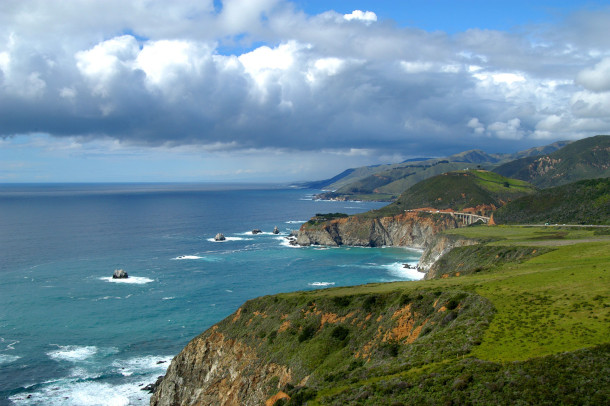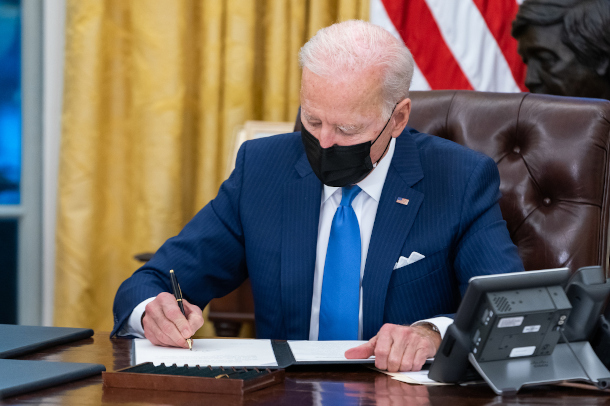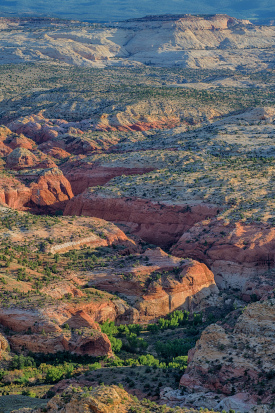30x30 To Save Species
Air Date: Week of March 12, 2021

Around 23% of United States waters are either fully or highly protected, like the Monterey Bay National Marine Sanctuary, here seen offshore of California’s Big Sur coastline. The 30 by 30 movement seeks to protect 30% of land and water by 2030, as a steppingstone to protecting 50% of the globe by 2050. (Photo: Robert Schwemmer, CIMS, NOAA, Wikimedia Commons, Public Domain)
President Joe Biden has set an official goal of protecting 30% of US land and ocean for conservation by 2030, on the way to preserving 50% by 2050. This echoes similar pledges by dozens of governments around the globe. Brett Hartl, the Government Affairs Director for the Center for Biological Diversity, joins Host Bobby Bascomb for more.
Transcript
CURWOOD: It’s Living on Earth, I’m Steve Curwood.
BASCOMB: And I’m Bobby Bascomb
President Biden has set an official goal of protecting 30% of US land and ocean for conservation by 2030, on the way to preserving 50% by 2050. Dozens of other national governments have also pledged the same goals. Brett Hartl is the Government Affairs Director for the Center for Biological Diversity. He says protecting nature helps address the climate emergency by sequestering carbon. At the same time it fights the extinction crisis while there is still time to conserve critical habitats.
HARTL: We are so quickly exploiting natural resources that we are losing species before we even know what we've lost. And then, you know, even the United States, you know, we still have extinctions. 48 or so species have gone extinct while waiting for protections under the Endangered Species Act, because we just didn't have the resources to protect them all. And they're happening now also, because of climate change, species are going extinct as islands disappear from sea level rise and ecosystem shift. And species on the very tops of mountains have nowhere to go. It's happening. And it's and it's accelerating and getting worse. And if you save 30% of the planets, then maybe those species have a fighting chance.
BASCOMB: So averting mass extinction sounds like a very fine goal. What are the other benefits of protecting land and water?
HARTL: All of these challenges we face are interconnected. So if we protect a large amount of our lands and waters, we're also likely to be averting the climate crisis, we will likely just end up in a better, more sustainable path when it comes to how we exploit natural resources. And then frankly, in the long run, it'll help us create a hopefully a more just and equitable planet, overall, so that we aren't in a mad dash to extract resources in the most reckless way possible. It'll help force us come to grips with a very simple fact, this is a finite planet. And we cannot continue consuming resources as if they are inexhaustible, because the opposite is true. And I'll say perhaps in the most current situation that's playing out still right now, it's important to remember that the COVID 19 pandemic, most likely came from wildlife, and in particular, the exploitation, the unsustainable exploitation of wildlife. And it only happens because we have such an unsustainable relationship with the natural world. So there's many benefits, perhaps most importantly, it is our very survival.
BASCOMB: Yeah, that's a really good point. And can you talk a bit more about how conserving land and water could help in terms of climate change and carbon sequestration?

President Joe Biden has signed dozens of executive orders, including the order that set a federal goal of protecting 30% of US land and ocean for conservation by 2030. (Photo: Adam Schultz, The White House, Flickr, Public Domain)
HARTL: First, we should remember that I think it's about a quarter of the fossil fuels that we consume come from our public lands and water, President Biden in this very same executive order, he put a pause on leasing new oil and gas leasing on public lands and waters to ask that very specific question, what do we need to do to save the climate when it comes to sort of how we deal with fossil fuels on public lands? So it's very much a related question. If we protected more of our public lands, if we manage them more for long term biodiversity for long term carbon sequestration, or we didn't log them all all the time, it would make a huge dent in the climate crisis, because our public lands and waters actually can sequester and lock away large amounts of carbon dioxide if we give them the chance. So that's probably the most direct way that it addresses the climate crisis. But I would say in general, we should always remember that natural ecosystems, whether that's mangroves or seagrass, or natural grasslands, of old growth forests, I don't want to miss a category, but they all have huge potential to sequester carbon, but they can't do it if they are trashed. So by protecting more of these lands, we have a better chance of having nature help us fight climate change, rather than sort of making it worse.
BASCOMB: Well, where does the US stand right now in terms of the amounts of land and water that's currently protected?
HARTL: Right. So there's different categories and levels of protection. According to the US Geological Survey, about 12% of our lands are sort of in the fully protected category, whether it's sort of national park, wilderness, etc. And that's probably about 20, something percent of our oceans are fully protected as national monuments and things like that. If you look at the entire public lands in this country, it's about a third of our land is actually public lands. But many of that, as we as I said earlier, is not protected. It is used for extraction of resources. So it actually does not count towards the goal of achieving 30% protections. But it's important just to note that even if we protected every acre of public lands, they're not distributed evenly in the country. So a lot of them are in Alaska, a lot of them are in the western United States. But we would miss actually huge parts of the country where many, many different species of wildlife and plants are found, that would have no protections. And we would sort of miss the boat because the idea is we want to protect sort of the full diversity of our natural heritage. We don't want to just protect the iconic places which are really important to protect the Grand Canyon, Yosemite, Yellowstone, Denali, all these incredible areas, but we want to remember that there are biologically rich and important places throughout the country, and many of them still are unprotected.

This is a canyon in the Grand Staircase-Escalante National Monument, designated in 1996 but whose size was reduced by around half by President Trump. President Biden has ordered a review of this reduction, and the monument is expected to re-gain some of its area. (Photo: Bob Wick, Bureau of Land Management, Wikimedia Commons, Public Domain)
BASCOMB: So we have an executive order from President Biden for this goal of 30 by 30. But how does the government actually go about making it a reality?
HARTL: That is the $64,000 question. There's sort of two strategies. One, for publicly owned lands for our national forests, our Bureau of Land Management that lands, even our Defense Department lands, we can improve management, we can add additional protections, we can create new national monuments. You know, President Biden can create a monument unilaterally, it is often the first step before things become national parks, which is only something that Congress can do. So obviously, Congress has powers too, they could create additional parks, but we can protect, you know, more of our lands as monuments. Also just strengthen management, so we're not clear cutting everything and drilling everywhere. But we also do have tools to acquire land, we have things like the Land and Water Conservation Fund, which provides almost a billion dollars a year for land acquisition. And there's actually even more money potentially available because over the years, they underfunded and there's actually a surplus left. But we can buy new lands. And it's important for folks as a history lesson to appreciate. If you're in the east, every National Forest, and most of the national parks in the eastern half of the country, were all acquired. They were all purchased back in the Dust Bowl era, they had been private property. And we realized we needed to protect our watersheds and the headwaters of many of our rivers and we purchased them all. So it's not unprecedented to actually acquire land. And the third strategy is the Department of Interior has the ability to establish new wildlife refuges administratively, they can find willing sellers and do conservation easements. And they can create new wildlife refuges, if there's, you know, important wildlife to protect. So we have tools to even expand protected areas beyond just public lands, especially in the East and the Midwest and the South, where the Fish and Wildlife Service can create new refuges. But it's important just to note that we don't want to just see an executive order with nothing more, right? Executive orders can always be reversed by the next president, and we never know when the pendulum is going to shift back the other direction, which is why we want to see that steady progress, you just never know how long an opportunity you have. And if you wait till you're three or four to get really going. It's harder to make that last in the long run, that would just be a lost opportunity.
BASCOMB: Well, you know, there's less than a decade to go to get to 2030. What's your hope for the next few years? What will progress towards this goal look like both in the US and around the world?
Brett Hartl is the Government Affairs Director for the Center for Biological Diversity. (Photo: Brett Hartl)
HARTL: I think in the US progress on 30 by 30, you know, it looks like a couple of things. One, I sincerely hope that President Biden is proactive in creating new national monuments. Historically, what often happens, and this happened with President Clinton, it happened with President Bush, it happened with President Obama, they wait to like the last year in office or something before they they go on a flurry of designating new national monuments as a legacy thing. And that's great. I mean, that's all positive. But my biggest fear is that, you know, all we see is like a report and a strategy. And we sort of procrastinate on our homework. Because it's a big goal. Again, if we're at 12%, now, we need to get to 30. That's several 100 million acres. It would be great if every year President Biden created 10 new national monuments to remind the public every year of how important they are and to try to, you know, space them out all around the United States so that people see them and appreciate them. The longer a monument is around, people are like, wow, that's a huge benefit to us. It increases tourism, it brings in new, you know, interest into our area. I'd say second, you know, we obviously really hope that after the pause on oil and gas leasing is over, that the Biden administration moves to quickly sort of phasing out fossil fuel development on public lands and waters. President Biden said on the campaign, no more drilling on public lands several times. And he's right, this is a polluting industry that's destroying the environment. And it's the primary cause of climate change. And frankly, there's more than enough fossil fuels coming off of other private lands that we just don't need to do this anymore. When I think at the global level, I would just say, there are conversations and international treaties that are discussing this issue right now, including what's called the Convention on Biological Diversity. Unfortunately, the United States is not a party to that treaty. We are, unfortunately one of like three or four countries that never signed that particular treaty, but the rest of the world did and the rest of the world is considering adopting officially the 30 by 30 goal. So we should support that and surely that even if for us, we can't officially sign on to it because we are not in the treaty. But if the world does agree to that goal, the United States can help other countries. We can provide support, technical assistance, financial assistance, to help make that real so that all of these countries benefit from doing the right thing, so that it isn't just on paper.
BASCOMB: Brett Hartl is the Government Affairs Director for the Center for Biological Diversity. Brett, thank you so much for taking this time with me today.
HARTL: Thanks for chatting.
Links
The Center for Biological Diversity’s press release on President Biden’s executive order
Natural Resources Defense Council | “Biden’s Historic Action on 30x30”
Living on Earth wants to hear from you!
Living on Earth
62 Calef Highway, Suite 212
Lee, NH 03861
Telephone: 617-287-4121
E-mail: comments@loe.org
Newsletter [Click here]
Donate to Living on Earth!
Living on Earth is an independent media program and relies entirely on contributions from listeners and institutions supporting public service. Please donate now to preserve an independent environmental voice.
NewsletterLiving on Earth offers a weekly delivery of the show's rundown to your mailbox. Sign up for our newsletter today!
 Sailors For The Sea: Be the change you want to sea.
Sailors For The Sea: Be the change you want to sea.
 The Grantham Foundation for the Protection of the Environment: Committed to protecting and improving the health of the global environment.
The Grantham Foundation for the Protection of the Environment: Committed to protecting and improving the health of the global environment.
 Contribute to Living on Earth and receive, as our gift to you, an archival print of one of Mark Seth Lender's extraordinary wildlife photographs. Follow the link to see Mark's current collection of photographs.
Contribute to Living on Earth and receive, as our gift to you, an archival print of one of Mark Seth Lender's extraordinary wildlife photographs. Follow the link to see Mark's current collection of photographs.
 Buy a signed copy of Mark Seth Lender's book Smeagull the Seagull & support Living on Earth
Buy a signed copy of Mark Seth Lender's book Smeagull the Seagull & support Living on Earth

